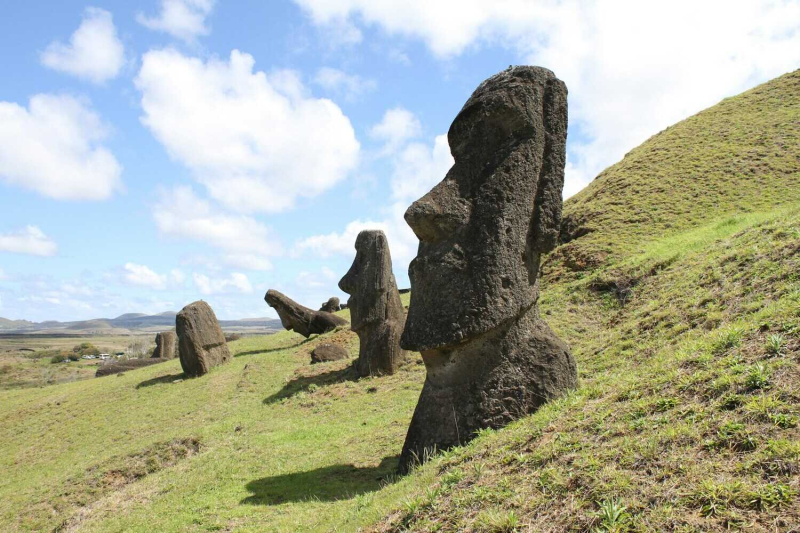
© Thomas Griggs/Unsplash
For several decades, traditional historiography has taught that the first traces of writing date back to the fourth millennium BC, in Mesopotamia (geographical area including present-day Iraq and Syria) . This would then have spread across the world. However, an in-depth study of the Rongorongo tablets from Easter Island (discovered in the 19th century), suggests that we may have underestimated the peoples who lived isolated from the rest of the world.
A study from the University of Bologna has presented indirect evidence suggesting that the Polynesian people also invented a form of’ writing, well before the arrival of the Europeans.
A revolutionary discovery
< p>The study in question from the University of Bologna, led by Silvia Ferrara, professor of philology, was published in the journal Nature February 2, 2024. It was by dating the wood of the Rongorongo tablets that the researchers were able to establish this observation. These artifacts predated the arrival of the first European explorers on the island.
These tablets are engraved with symbols representing many elements: humans, animals, plants, tools, body parts or celestial bodies. This would therefore mean that these tablets would represent the potential fifth occurrence of the invention of writing independently by being human. The other four being: Mesopotamia (end of the fourth millennium BC), Egypt (around 3200 BC), China (1200 BC .-C.) and Mesoamerica (between 900 and 300 BC).
For Ferrera, this discovery is d& ;#8217;of capital importance: « This would be a major step forward in understanding how many times human beings have reached the decisive moment of the invention of writing “.
The method behind the dating
To arrive at this conclusion, the dating was performed by radiocarbon. This method was suggested by Sahra Talamo, co-author of the study, professor of chemistry at the University of Bologna and director of the Bologna Radiocarbon Laboratory devoted to Human Evolution (BRAVHO).
Also known as carbon-14 dating, which is “ the most widely used isotopic method. It is based on the progressive disintegration of carbon 14 (C14), one of the three isotopes of carbon ” according to Inrap. It’is a technique that makes it possible to estimate the age of organic materials by measuring the quantity of carbon contained by them ci.
We know that carbon-14 decays at a known rate when an organism dies. When we compare a sample (in this case, a piece of the Rongorongo tablets) to a living sample, we can determine when the organism stopped absorbing carbon , and therefore to estimate his age.
This method has been approved by the Congregazione dei Sacri Cuori di Gesù e di Maria in Rome. Indeed, dating a sample with this technique requires taking samples from the material to be tested, therefore d’destroying small pieces. However, this approach made it possible to precisely date these tablets by revealing that the wood of one of them dated to around 1450. Well before the arrival of Europeans in 18th century.
Talamo explains: “ We precisely dated the moment when the tree was cut down. It is crucial to take into account that with the passage of months, days, or even years, if the tree is not well preserved, it could dry out, making the wood impossible to use for writing ”. She continues: “ It is therefore probable that the engraving was made around the same time, or not much later& ;nbsp;”.
This discovery would indicate that the people of Rapa Nui would have independently developed a writing system. A remarkable fact given the extreme isolation of the island.
Consequences of this discovery
The idea that the invention of writing was only limited to a few great civilizations of the ancient world was then greatly disrupted. This means that societies isolated from major centers of cultural development are also capable of innovations as important as writing. As Ferrara explains: “ If human beings have independently invented a writing system four times, the question is, why not more’ nbsp;? Indirect evidence points in this direction “.
From a more global point of view, this discovery allows us to approach a more nuanced perspectiveon human prehistory and its link with technology. Innovation can indeed emerge from very varied contexts, and not only within the great civilizational powers; writing is perhaps only one example.
In addition, this will certainly encourage researchers to investigate other regions of the world that have not benefited in-depth studies. This is to look for evidence of inventions that may still be hidden or undiscovered. If there is one lesson to be learned from the secret of the Rongorongo tablets: history is always full of surprises, and our understanding of them will be always subject to revision.
- A study from the University of Bologna looked at the Rongorongo tablets from Easter Island.
- The researchers discovered that Polynesian peoples invented writing around 1450, well before the arrival of the first Europeans
- This discovery implies that innovations as important as writing are not exclusive to great civilizations as has always been believed until now.
📍 To not miss any news from Presse-citron, follow us on Google News and WhatsApp.
[ ]

